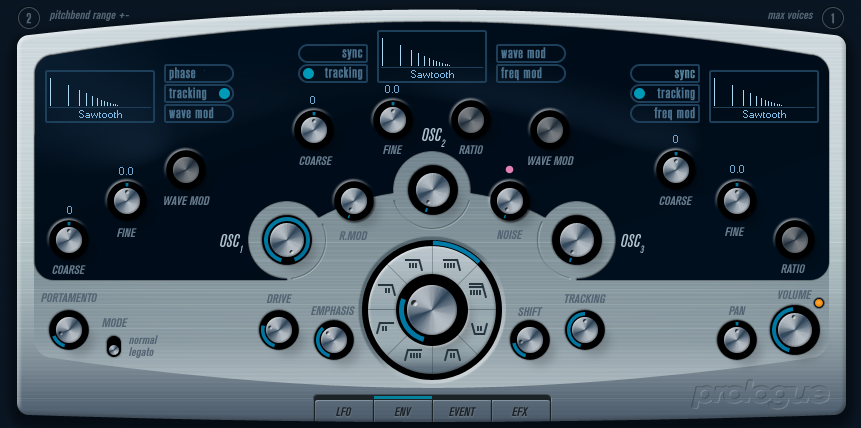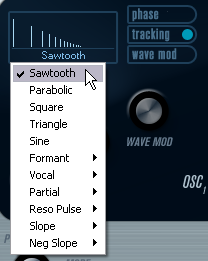Oscillator Section

This section contains parameters affecting the 3 oscillators. These are located in upper half of the instrument panel.
Selecting Waveforms
Each oscillator has a number of waveforms that can be selected by clicking on the waveform name in the box located in each oscillator section.

- Sawtooth
This waveform contains all harmonics and produces a bright and rich sound.
- Parabolic
This can be described as a rounded sawtooth waveform, producing a softer timbre.
- Square
Square waveforms only contain odd number harmonics, which produces a distinct, hollow sound.
- Triangle
The triangle waveform generates only a few harmonics, spaced at odd harmonic numbers, which produces a slightly hollow sound.
- Sine
The sine wave is the simplest possible waveform, with no harmonics (overtones). The sine wave produces a neutral, soft timbre.
- Formant 1–12
Formant waveforms emphasizes certain frequency bands. Like the human voice, musical instruments have a fixed set of formants, which give it a unique, recognizable tonal color or timbre, regardless of pitch.
- Vocal 1–7
These are also formant waveforms, but specifically vocal-oriented. Vowel sounds (A/E/I/O/U) are among the waveforms found in this category.
- Partial 1–7
Partials, also called harmonics or overtones, are a series of tones which accompany the prime tone (fundamental). These waveforms produce intervals with two or more frequencies heard simultaneously with equal strength.
- Reso Pulse 1–12
This waveform category begins with a complex waveform (Reso Pulse 1) that emphasizes the fundamental frequency (prime). For each consecutive waveform in this category, the next harmonic in the harmonic series is emphasized.
- Slope 1–12
This waveform category begins with a complex waveform (Slope 1), with gradually decreasing harmonic complexity the higher the number selected. Slope 12 produces a sine wave (no harmonics).
- Neg Slope 1–9
This category also begins with a complex waveform (NegSlope 1), but with gradually decreasing low frequency content the higher the number selected.
To hear the signal generated by the oscillators, the corresponding Osc controls in the oscillator sections must be set to a suitable value.
OSC 1 Parameters
Oscillator 1 acts as a master oscillator. It determines the base pitch for all three oscillators.
- Osc 1 (0–100)
This controls the output level of the oscillator.
- Coarse (±48 semitones)
This determines the base pitch used by all oscillators.
- Fine (±50 cent)
Fine-tunes the oscillator pitch in cent increments (100th of a semitone). This also affects all oscillators.
- Wave Mod (±50)
This parameter is only active if the Wave Mod button is activated beside the waveform selection box. Wave modulation works by adding a phase-shifted copy of the oscillator output to itself, which produces waveform variations. For example if a sawtooth waveform is used, activating WM produces a pulse waveform. By modulating the WM parameter with for example an LFO, classic PWM (pulse width modulation) is produced. However, wave modulation can be applied to any waveform.
- Phase button (On/Off)
If phase synchronization is activated, all oscillators restart their waveform cycles with every note that is played. With Phase deactivated, the oscillators generate a waveform cycle continuously, which produces slight variations when playing as each note starts from a random phase in the cycle, adding warmth to the sound. For bass sounds or drum sounds, it is often required that the attack of every note sounds the same, therefore, for these purposes activate phase sync. Phase sync also affects the noise generator.
- Tracking button (On/Off)
If Tracking is activated, the oscillator pitch tracks the notes played on the keyboard. If Tracking is deactivated, the oscillator pitch remains constant, regardless of the note that is played.
- Wave Mod button (On/Off)
Activates/Deactivates wave modulation.
- Waveform pop-up menu
Sets the basic waveform for the oscillator.
OSC 2 Parameters
- Osc 2 (0–100)
Controls the output level of the oscillator.
- Coarse (±48semitones)
Determines the coarse pitch for Osc 2. If FM is enabled, this determines frequency ratio of the oscillator regarding Osc 1.
- Fine (±50 cent)
Fine-tunes the oscillator pitch in cent increments (100th of a semitone). If FM is activated, this determines the frequency ratio of the oscillator regarding Osc 1.
- Wave Mod (±50)
This parameter is only active if the Wave Mod button next to the waveform selector is activated. Wave modulation works by adding a phase-shifted copy of the oscillator output to itself, which produces waveform variations. For example, if a sawtooth waveform is used, activating WM produces a pulse waveform. By modulating the WM parameter with an LFO, classic PWM (pulse width modulation) is produced. Wave modulation can be applied to any waveform.
- Ratio (1–16)
This parameter is only active if Freq Mod is activate. It adjusts the amount of frequency modulation applied to oscillator 2. It is normally referred to as FM index.
- Sync button (On/Off)
If Sync is activated, Osc 2 is slaved to Osc 1. This means that every time Osc 1 completes its cycle, Osc 2 is forced to start its cycle from the beginning. This produces a characteristic sound, suitable for lead playing. Osc 1 determines the pitch, and varying the pitch of Osc 2 produces changes in timbre. For classic sync sounds, try modulating the pitch of Osc 2 with an envelope or an LFO. The Osc 2 pitch should also be set higher than the pitch of Osc 1.
- Tracking button (On/Off)
If Tracking is activated, the oscillator pitch tracks the notes played on the keyboard. If Tracking is deactivated, the oscillator pitch remains constant, regardless of the note that is played.
- Freq Mod button (On/Off)
Activates/Deactivates frequency modulation.
- Wave Mod button (On/Off)
Activates/Deactivates wave modulation.
- Waveform pop-up menu
Sets the basic waveform for the oscillator.
OSC 3 Parameters
- Osc 3 (0–100)
Controls the output level of the oscillator.
- Coarse (±48semitones)
Determines the coarse pitch for Osc 3. If FM is activated, this determines the frequency ratio of the oscillator regarding Osc 1/2.
- Fine (±50 cent)
Fine-tunes the oscillator pitch in cent increments. If FM is activated, this determines the frequency ratio of the oscillator regarding Osc 1/2.
- Ratio (1–16)
This parameter is only active if the Freq Mod button is activated. It adjusts the amount of frequency modulation applied to oscillator 3. It is normally referred to as FM index.
- Sync button (On/Off)
If Sync is activated, Osc 3 is slaved to Osc 1. This means that every time Osc 1 completes its cycle, Osc 3 is forced to start its cycle from the beginning. This produces a characteristic sound, suitable for lead playing. Osc 1 determines the pitch, and varying the pitch of Osc 3 produces changes in timbre. For classic sync sounds, try modulating the pitch of Osc 3 with an envelope or an LFO. The Osc 3 pitch should also be set higher than the pitch of Osc 1.
- Tracking button (On/Off)
If Tracking is activated, the oscillator pitch tracks the notes played on the keyboard. If Tracking is deactivated, the oscillator pitch remains constant, regardless of the note that is played.
- Freq Mod button (On/Off)
Activates/Deactivates frequency modulation.
- Wave Mod button (On/Off)
Activates/Deactivates wave modulation.
- Waveform pop-up menu
Sets the basic waveform for the oscillator.
About Frequency Modulation
Frequency modulation or FM means that the frequency of one oscillator, called the carrier, is modulated by the frequency of another oscillator, called the modulator.
In Prologue, Osc 1 is the modulator, and Osc 2 and 3 are carriers.
However, Osc 2 can be both carrier and modulator as if frequency modulation is applied to Osc 2 it is modulated by Osc 3. If Osc 2 also uses frequency modulation, Osc 3 is modulated by both Osc 1 and Osc 2.
The pure sound of frequency modulation is output through the modulator oscillators.
This means that you should turn off the Osc 1 output when using frequency modulation.
The Freq Mod button activates/deactivates frequency modulation.
The Ratio parameter determines the amount of frequency modulation.
Portamento
This parameter makes the pitch glide between the notes you play. The parameter setting determines the time it takes for the pitch to glide from one note to the next. Turn the knob clockwise for longer glide time.
The Mode switch allows you to apply glide only if you play a legato note. Legato mode only works with monophonic parts.
Ring Modulation
Ring modulators multiply two audio signals. The ring-modulated output contains added frequencies generated by the sum of, and the difference between, the frequencies of the two signals. In Prologue, Osc 1 is multiplied with Osc 2 to produce sum and difference frequencies. Ring modulation is often used to create bell-like sounds.
To hear the ring modulation, turn down the output level for Osc 1 and 2, and turn up the R.Mod level all the way.
If Osc 1 and 2 are tuned to the same frequency and no modulation is applied to the Osc 2 pitch, nothing happens.
However, if you change the pitch of Osc 2, drastic changes in timbre can be heard. If the oscillators are tuned to a harmonic interval, such as fifth or octave, the ring modulated output sounds harmonic, other intervals produce inharmonious, complex timbres.
Deactivate oscillator sync when using ring modulation.
Noise Generator
A noise generator can be used for simulating drum sounds and breath sounds for wind instruments, for example.
To hear only the sound of the noise generator, turn down the output level for the oscillators, and turn up the Noise parameter.
The noise generator level is routed to Envelope 1 by default.